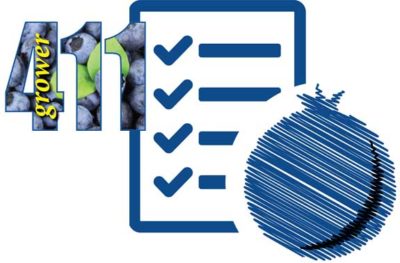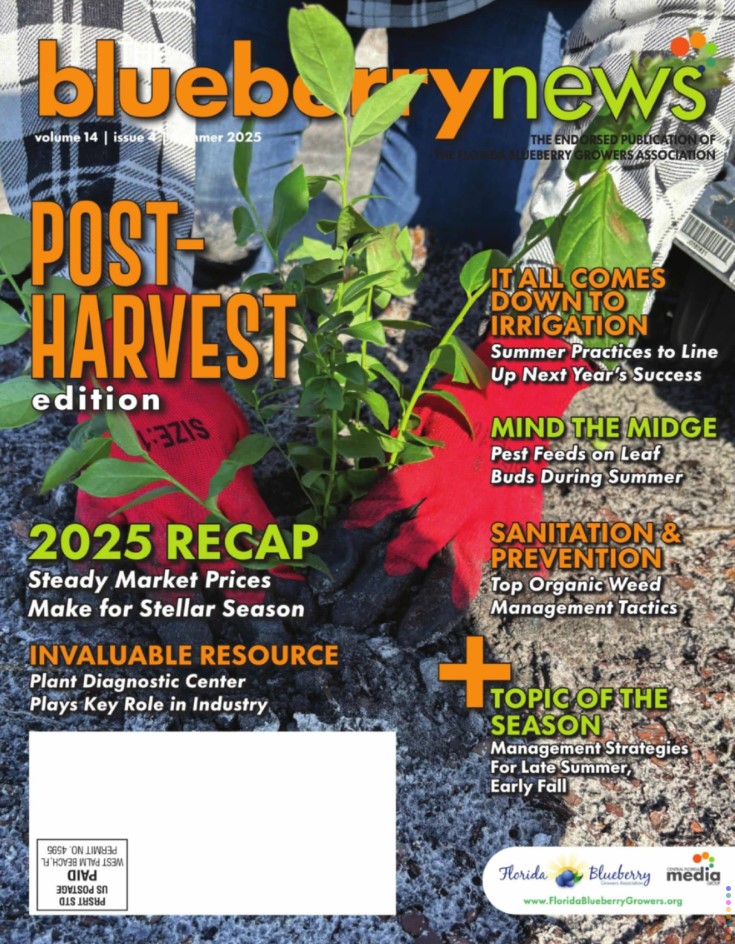
VIRTUALLY ALL blueberry fields in Florida are subject to late winter or early spring freezes, which can cause serious reductions in yield. Below is a list of activities for freeze preparation. The list was originally published by Mike Mainland in the North Carolina Blueberry News, Vol. 7, No. 1 and has been modified by IFAS faculty and FBGA board members.
1. Flush all overhead sprinklers to clear debris— remove heads and flush.
2. Test and service the pumping units, replace filters, and have spare filters available.
3. Treat diesel tanks for water and algae.
4. Check lines and sprinklers in the field for leaks and clogged nozzles.
5. Check water pressure on ends of distant lines.
6. Make sure drainage in and around fields is adequate. Make sure roadways around and through the fields will withstand traffic at night during irrigation.
7. Remove or relocate any equipment that may pose a danger to vehicular traffic.
8. Have a (remote controlled, magnetic roof mounted) high-intensity spotlight ready to plug into the truck to check sprinklers.
9. Put shielded minimum thermometers in cold, average, and warm areas of fields — at the average height of the middle of the bushes.
10. Consider purchasing weather stations that communicate real-time weather conditions to computers and smartphones.
11. Hang some ribbons on trees or poles around fields to detect slight breezes.
12. Identify a good source of agricultural weather information and watch it closely. Consider subscribing to a weather service that issues freeze warnings.
13. Consider purchasing a monitor that calls you when the temperature gets low.
14. Consider purchasing a hand-held wind meter or anemometer to measure wind speed. If you already own one, consider re-calibrating to manufacturer specifications.
15. Consider purchasing a sling psychrometer to measure wet bulb and dry bulb temperatures, relative humidity, and dew point.
16. Have rain suits and boots available for everyone responsible for checking the irrigation system.
17. Have wires available to unclog nozzles.
18. Have tools and replacement parts that are necessary to exchange nozzles and/or sprinklers.
19. Be certain you know the “safe cutoff temperature” before you shut down your overhead freeze protection irrigation. This temperature can be as high as 40 degrees Fahrenheit if the dew point is low and wind is high.
a. Be familiar with the relationship between the critical temperature of the crop and wet bulb temperature. In blueberries, critical temperature rises as the plants transition from tight bud to fruit set. On mornings following freeze protection nights, the irrigation system should not be turned off until the wet bulb temperature reading is significantly higher than the critical temperature throughout the field. When low dew points are coupled with significant winds, the wet bulb temperature can be three to five degrees below the ambient temperature.
20. Fill all vehicles with fuel before the freeze event.
21. Have help available or on call if needed for emergencies.





